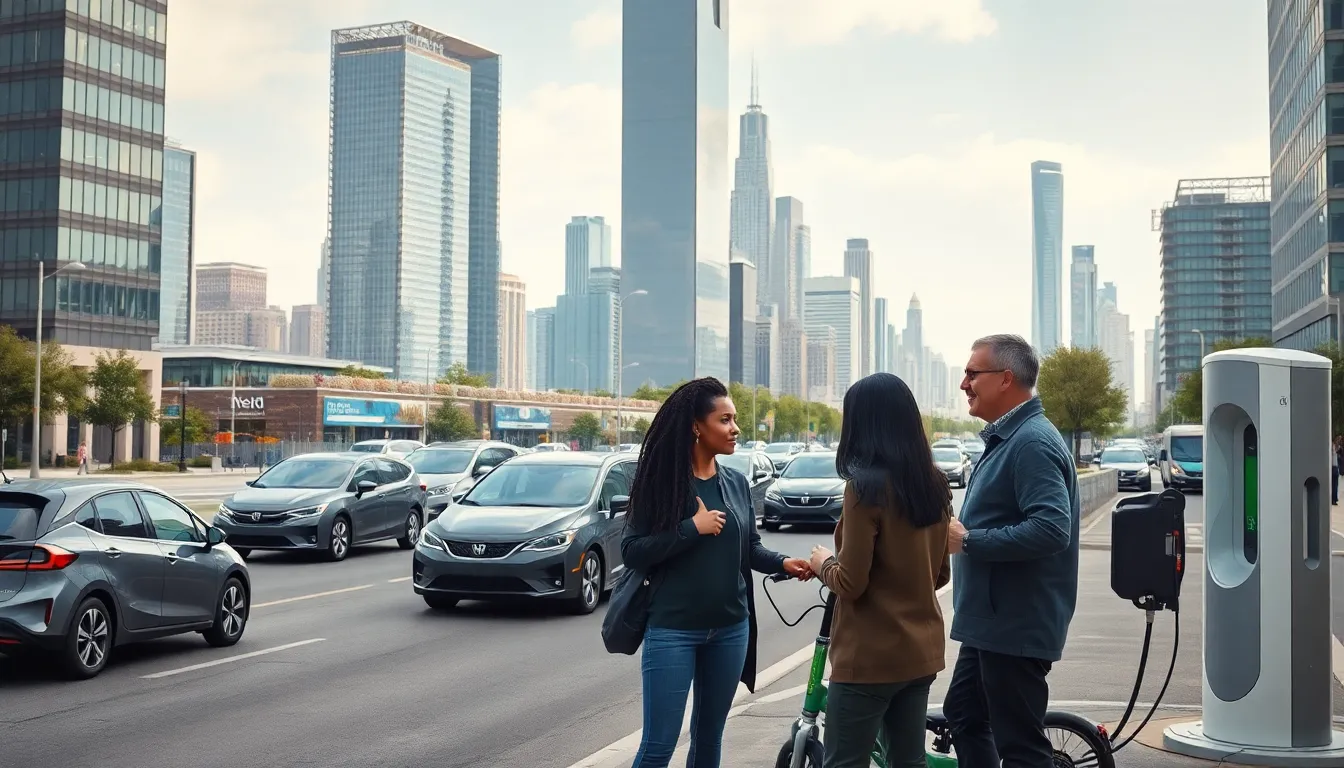The future of getting from point A to point B is zooming in faster than a kid on a sugar rush. Emerging transportation technologies are not just about fancy gadgets; they’re reshaping how people think about travel. Imagine hopping into a self-driving car that knows your coffee order better than your best friend. Sounds like a sci-fi movie, right? Welcome to the new reality.
Table of Contents
ToggleOverview of Emerging Transportation Technologies
Emerging transportation technologies are reshaping how people travel. Electric vehicles (EVs) are gaining traction, contributing to reduced emissions and lower operating costs. With advancements in battery technology, EVs offer longer ranges, enhancing convenience for users.
Additionally, connected and autonomous vehicles (CAVs) are transforming safety and efficiency on the roads. They utilize sensors and artificial intelligence to navigate complex environments, lowering accident rates significantly. In fact, studies indicate that fully autonomous vehicles could reduce crashes by up to 90%.
Public transportation is also evolving through innovations like smart transit systems. These systems integrate real-time data, optimizing routes and schedules based on rider demand. Cities employing smart transit report increased ridership and improved commuter satisfaction.
Drones and aerial taxis are entering the conversation, promising rapid urban transportation solutions. Companies are exploring the feasibility of air mobility solutions that could alleviate congestion in densely populated areas. Pilot programs in various cities suggest that aerial transportation could provide effective alternatives to traditional ground transport.
Hyperloop technology is redefining long-distance travel. By utilizing magnetic levitation and vacuum-sealed tubes, hyperloop systems aim to achieve speeds over 700 miles per hour. This technology could drastically cut travel times between major cities, making it a game changer for intercity transportation.
Electric and hydrogen fuel cell technologies are becoming prominent in commercial applications. Buses and trucks powered by these systems are already operational in several places, proving to be environmentally friendly alternatives to diesel-powered vehicles. Their expansion indicates a significant shift toward sustainable logistics.
Adoption of emerging transportation technologies reflects a broader trend toward smarter cities and sustainable travel solutions. These innovations not only enhance personal convenience but also contribute to a healthier planet.
Key Trends Shaping the Future

Transportation technology continues to evolve rapidly, leading to significant changes in how people navigate their environments. Innovations drive efficiency, sustainability, and safety across various modes of transport.
Automation and Autonomous Vehicles
Automation plays a crucial role in modern transport systems. Self-driving cars, which leverage advanced machine learning algorithms, can personalize experiences by anticipating preferences like coffee orders. Data indicates that these autonomous vehicles may lower accident rates by 90%. Safety features, artificial intelligence, and connected car technology enhance the driving experience and streamline traffic flow. Regulations evolve to accommodate automation advancements, ensuring a smoother transition to these innovative solutions. Furthermore, partnerships between tech companies and automotive manufacturers accelerate the development of autonomous fleets for ridesharing and logistics.
Electrification of Transportation
Electrification is redefining the future of transportation. Electric vehicles (EVs), which reduce emissions significantly, represent a crucial shift toward sustainable travel. Market adoption of EVs is rapidly increasing, driven by advancements in battery technology that enhance range and efficiency. Shared electric scooters and bicycles are becoming popular last-mile solutions in urban areas. The rise of hydrogen fuel cell technologies also points to a diverse energy landscape. Cities are investing in charging infrastructure to support EVs, promoting adoption and reducing reliance on fossil fuels. Data underscores that the transformation toward electric-powered transport marks a significant change in logistics and personal travel practices.
Impact on Urban Mobility
Emerging transportation technologies significantly transform urban mobility, reshaping how residents navigate their cities. Integration of smart cities and advanced connectivity enhances efficiency and safety within urban transport systems.
Smart Cities and Connectivity
Smart cities leverage data and connectivity to optimize transportation networks. Real-time information on traffic conditions streamlines commutes. Intelligent traffic signals adapt based on vehicle flow, reducing congestion and enhancing travel times. Multiple cities implement connected infrastructure, enabling vehicles to communicate with traffic systems. Continuous monitoring leads to preventative measures against potential accidents. Collaborative efforts among municipalities and tech companies further accelerate advancements in smart mobility solutions.
Last-Mile Delivery Solutions
Last-mile delivery strategies streamline the final leg of transport, ensuring efficient package distribution. Electric vehicles and drones play crucial roles in minimizing emissions while improving speed. Implementing autonomous vehicles offers innovative alternatives for urban delivery, providing convenience for consumers. Tech companies continually refine logistics platforms to optimize routes and cut costs. Data analytics assists in predicting demand, enabling rapid adjustments in delivery operations. Cities increasingly adopt these technologies, enhancing accessibility for residents while promoting sustainable practices.
Challenges Facing Adoption
Emerging transportation technologies face several significant challenges that hinder their widespread adoption. Key issues revolve around regulatory hurdles and infrastructure readiness.
Regulatory Hurdles
Regulatory challenges play a major role in the adoption of new transportation technologies. Governments struggle to create cohesive regulations that can keep pace with rapid advancements. Uncertainty prevails as agencies grapple with overseeing self-driving car safety and data privacy. Complicated approval processes often delay the introduction of innovative solutions into the market. Stakeholders advocate for clear guidelines that facilitate experimentation while ensuring public safety. Collaboration between industry leaders and policymakers can lead to effective regulatory frameworks that foster innovation.
Infrastructure Readiness
Infrastructure readiness remains a critical challenge for integrating emerging technologies into transportation systems. Existing roads and public transit networks often require significant upgrades to accommodate electric vehicles and autonomous systems. Many cities lack sufficient charging stations, which can impede electric vehicle adoption. Additionally, smart transportation systems necessitate advanced network capabilities, such as 5G connectivity. Investments in technology and infrastructure may enable cities to support innovations like drones and smart traffic management. Planning for future demands ensures that urban environments align with advancements in mobility solutions.
Future Outlook
Innovations in transportation technologies promise a transformative future. Rapid advancements indicate a shift towards automated systems, making self-driving cars more integrated into daily life. Effective partnerships between tech firms and automakers accelerate the deployment of autonomous fleets for ridesharing and logistics. Increased safety on the roads remains a priority, with predictions of accident rates decreasing by up to 90% due to connected and autonomous vehicles.
The electrification of transport continues to gain momentum. Battery technology advancements drive electric vehicle adoption, leading cities to invest in extensive charging infrastructure. Cities recognize the importance of supporting sustainable travel, and hydrogen fuel cell vehicles also contribute to reducing emissions.
Smart transit systems emerge as a response to urban mobility needs. Integration of real-time data optimizes transportation networks, enhancing commuter satisfaction. Intelligent traffic signals adapt to vehicle flow, alleviating congestion significantly. Many cities now focus on last-mile delivery solutions, with electric vehicles and drones enhancing efficiency while minimizing environmental footprints.
Challenges remain on the horizon for widespread technology adoption. Regulatory hurdles frequently hinder progress, as governments seek cohesive regulations to address safety and data privacy issues. Infrastructure inadequacies can stall advancements, as many existing transportation networks require modernization to support new technologies. Cities must prioritize investments in technology and infrastructure to create resilient urban environments. The alignment of transportation systems with technological advancements plays a crucial role in shaping the future of mobility solutions.
Emerging transportation technologies are set to redefine the way people navigate their environments. With advancements in automation and electrification leading the charge, the potential for safer and more efficient travel is immense. Cities that embrace these innovations will not only enhance commuter experiences but also promote sustainable practices that benefit the planet.
However, addressing the existing challenges is crucial. Regulatory frameworks and infrastructure readiness must evolve to support these technologies. As investments in smart transit systems and charging networks increase, urban mobility will likely transform, paving the way for a future where travel is seamless and environmentally friendly. The journey towards this future is just beginning, and the possibilities are exciting.



